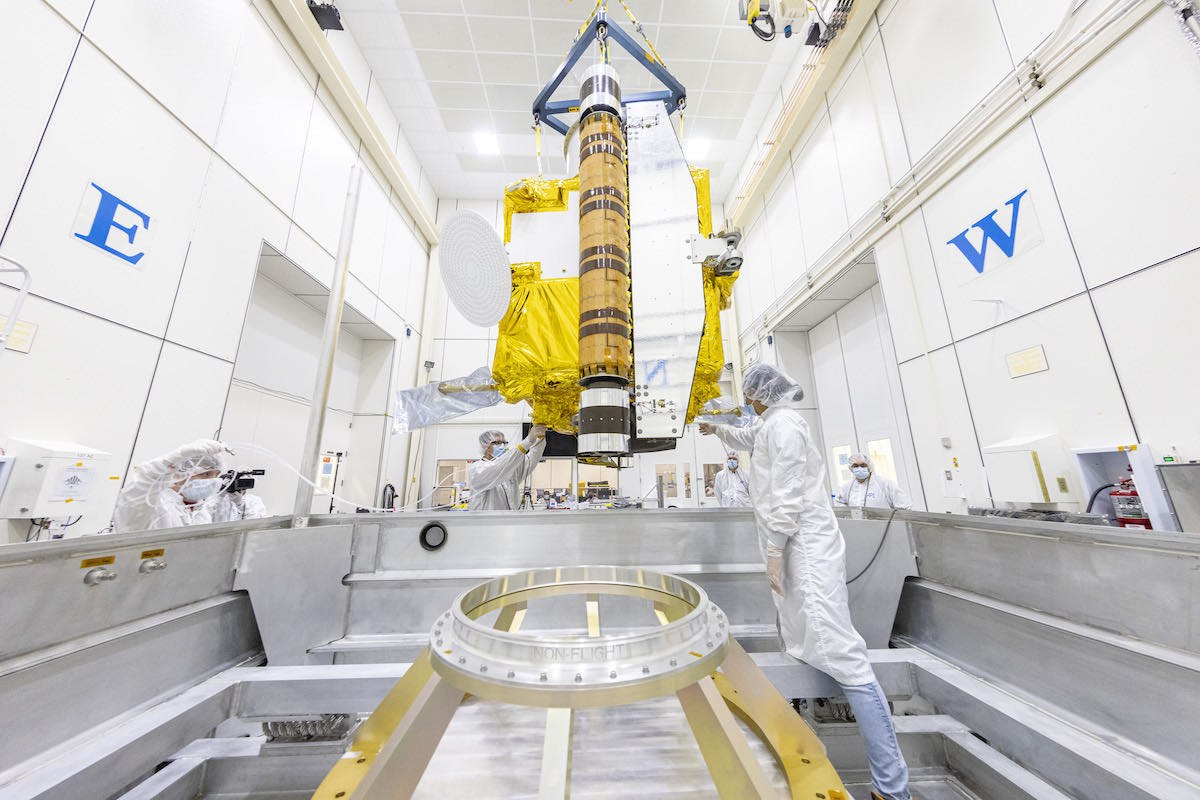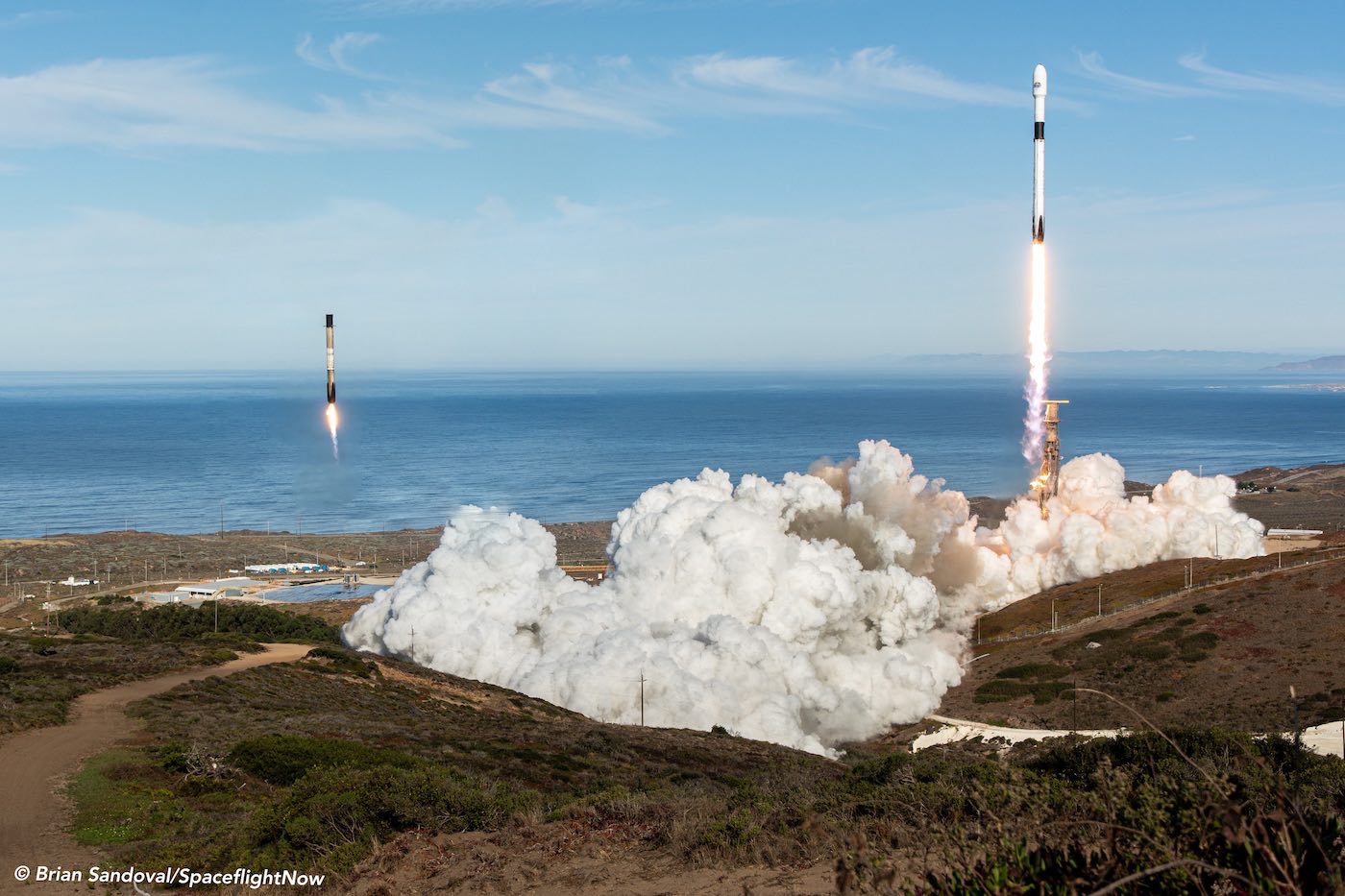Space News & Blog Articles
Spacecraft for asteroid deflection experiment ready for fueling
 The DART spacecraft is moved into a shipping container last month at the Johns Hopkins University Applied Physics Laboratory. Credit: NASA/Johns Hopkins APL/Ed Whitman
The DART spacecraft is moved into a shipping container last month at the Johns Hopkins University Applied Physics Laboratory. Credit: NASA/Johns Hopkins APL/Ed Whitman
A small spacecraft built for a NASA asteroid defense experiment arrived at Vandenberg Space Force Base in California earlier this month and is ready for fueling, one of the final milestones before liftoff in November on a SpaceX Falcon 9 rocket.
NASA’s Double Asteroid Redirection Test, or DART, spacecraft arrived at Vandenberg on Oct. 2 after a cross-country trip by truck from the Johns Hopkins University Applied Physics Laboratory in Laurel, Maryland.
Wishing a little more than a half-ton, DART is set for launch Nov. 23 at 10:20 p.m. PST (1:20 a.m. EST; 0620 GMT on Nov. 24) aboard a Falcon 9 rocket powered by a reused first stage booster. The mission has daily instantaneous launch opportunities through mid-February.
The Falcon 9 rocket will accelerate the spacecraft away from Earth on a trajectory toward asteroid Didymos, a rocky object about a half-mile (780 meters) in diameter.
Using a series of maneuvers with a xenon ion thruster, DART will take aim on Didymos’s smaller companion asteroid, called Dimorphos. The spacecraft will strike Dimorphos — about 525 feet (160 meters) wide — at nearly 15,000 mph (about 6.6 kilometers per second).
The primary science goal of the mission is to measure how the high-speed collision, which will destroy the DART spacecraft, disrupts the orbit of Dimorphos around nearby Didymos. The data could help plan a future mission to deflect an asteroid on a course to hit Earth.
Didymos and Dimorphos pose no near-term threat to Earth, but the asteroids will be close enough to our planet next year for astronomers to observe DART’s impact in late September using ground-based telescopes.
A small CubeSat provided by the Italian Space Agency will ride to space with DART, then deploy about 10 days before impact. The ridealong spacecraft, named LICIACube, will maneuver to a trajectory offset from DART, allowing it to safely fly by and watch the collision with a pair of optical cameras.
Since DART’s arrival at Vandenberg, engineers completed “basic electrical checkouts” to ensure the spacecraft remained healthy after the two-day road trip from its factory in Maryland, according to Betsy Congdon, the lead mechanical engineer for the DART mission at the Applied Physics Laboratory.
“Everything is working as planned, so now we’re getting into blanketing and final preparations for launch and fueling,” Congdon said Friday in an interview with Spaceflight Now.
This week, teams planned to move the DART spacecraft from an Astrotech processing facility to a nearby SpaceX clean room. Engineers completed the initial testing on DART at Astrotech, and will fuel the spacecraft with hydrazine at the SpaceX facility.
The hydrazine will feed 12 small rocket thrusters on the DART spacecraft. The rocket jets will be used for fine pointing of spacecraft during its 10-month flight to Didymos and Dimorphos.
 This composite image captures the launch of a Falcon 9 rocket from SLC-4E at Vandenberg last November with the Sentinel-6 Michael Freilich mission, followed by the booster’s return to Landing Zone 4 more than eight minutes later. The booster, designated B1063, will be used again for the DART mission. Credit: Brian Sandoval / Spaceflight Now
This composite image captures the launch of a Falcon 9 rocket from SLC-4E at Vandenberg last November with the Sentinel-6 Michael Freilich mission, followed by the booster’s return to Landing Zone 4 more than eight minutes later. The booster, designated B1063, will be used again for the DART mission. Credit: Brian Sandoval / Spaceflight Now
The DART spacecraft shipped from the Applied Physics Laboratory with xenon gas already loaded for its ion propulsion system. The mission will be the first for a new high-efficiency electric thruster developed by NASA’s Glenn Research Center and Aerojet Rocketdyne.
The NASA Evolutionary Xenon Thruster-Commercial, or NEXT-C, thruster will adjust DART’s trajectory toward its asteroid target. The new thruster is an upgraded, more powerful version of ion propulsion system used on previous NASA deep space probes.
Ion propulsion systems operate at low thrust, but they can fire continuously for months or years while consuming relatively little fuel. They work by accelerating ionized gas using electricity. In DART’s case, the electricity will be generated by two roll-out solar panels.
The DART mission was supposed to launch in July, but NASA announced earlier this year that the launch would slip to November due delays in delivering the spacecraft’s primary instrument and solar arrays.
NASA said the delay was caused by “technical challenges” associated with the spacecraft’s Didymos Reconnaissance and Asteroid Camera for Optical navigation, or DRACO, imaging system, which needed to be reinforced to ensure it can survive the stresses of a rocket launch.
The DRACO camera will take pictures of the Didymos and Dimorphos asteroids just before impact.
The delivery of the spacecraft’s Roll-Out Solar Arrays, known as ROSA, was delayed due to supply chain issues, partly blamed on the COVID-19 pandemic.
But those problems appear to behind DART.
Congdon said Friday the final activities to ready the DART spacecraft for hydrazine fueling included the installation of protective thermal blankets and harnesses. The launch is on schedule for late November.
“We have many days of margin,” she said. “Everything’s looking really good.”
This email address is being protected from spambots. You need JavaScript enabled to view it. the author.
Follow Stephen Clark on Twitter: @StephenClark1.
When you subscribe to the SpaceZE News Feed, we will send you an e-mail when there are new updates on the site so you wouldn't miss them.

